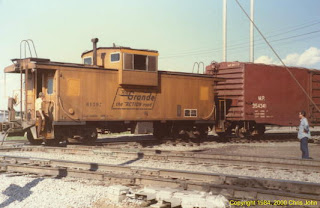Monday, March 16, 2009
Up Close
It is common to see these guys in Waterton Canyon. They pretty much ignore people which is not necessarily a good thing. This ram was just off the road and I was able to get this closeup. He appears to be watching me. The horns are quite worn and show some scars of the battle to see who would be the big cheese in the herd. Click on the picture for a larger view.

Friday, March 13, 2009
First time on youtube
I posted a video on YouTube. It is a special train heading from Denver to Pueblo for the State Fair a few years ago. It is steam-powered
Sunday, March 08, 2009
Climbing
When I was a kid, it was not unusual to find me up in a tree. My friend Kevin and I were climbers for sure. There was one tree in the neighbor's yard that was especally good for climbing. We'd get 30-40 feet up easily. I don't climb trees that often anymore. Well, in fact, I did climb one today to retrieve a geocache.
Here is a picture of me on top of a rock that I had to climb. It's from a few years ago and is in Rocky Mountain National Park.

Here is a picture of me on top of a rock that I had to climb. It's from a few years ago and is in Rocky Mountain National Park.
Saturday, March 07, 2009
One of my hidden geocaches
Friday, March 06, 2009
Thursday, March 05, 2009
The Train Crew (as I understand it)
At one time, it took 5 people to operate a typical train. In the locomotive, there was an engineer, a fireman, and a brakeman. In the caboose there was another brakeman and a conductor. In the steam days, the fireman's job was quite important as he was the guy who kept the fire going. The engineer operated the locomotive and the horns and no doubt lots of other gizmos. The head end brakeman obviously handled the brakes from the locomotive while the rear end brakeman handled the brakes from the caboose. The conductor in the caboose had all the paperwork for the train and was actually the person in charge of the train.
When diesels arrived, the fireman became a dunsel but was nevertheless kept in place for a long time due to union agreements. The same became true of both brakemen since the engineer could do all the braking for the train.
Eventually, the crew dwindled down to just the engineer and the conductor. It makes sense to have 2 people in the locomotive to support each other so the need for a caboose went away except for trains that had to run backwards for lots of switching moves. That's is the only type of train that still has a caboose today. The replacement for the caboose on regular trains is a "fred" - a flashing rear end device. It is a box of electronics that can monitor the systems on the train. This is one of the reasons for lots of antennas on today's locomotives.
P.S. I don't get to use the word "dunsel" very often.
When diesels arrived, the fireman became a dunsel but was nevertheless kept in place for a long time due to union agreements. The same became true of both brakemen since the engineer could do all the braking for the train.
Eventually, the crew dwindled down to just the engineer and the conductor. It makes sense to have 2 people in the locomotive to support each other so the need for a caboose went away except for trains that had to run backwards for lots of switching moves. That's is the only type of train that still has a caboose today. The replacement for the caboose on regular trains is a "fred" - a flashing rear end device. It is a box of electronics that can monitor the systems on the train. This is one of the reasons for lots of antennas on today's locomotives.
P.S. I don't get to use the word "dunsel" very often.
Tuesday, March 03, 2009
Cabooses were not all the same
The three below all have extended vision cupolas meaning the cuploas are wider than the body of the caboose. Two of them are very similar (BN and Rio Grande) but there are noticable differences. These two also have their windows plated over while the MP caboose does not.
Here is one from the Burlington Northern in Fort Worth, Texas in 1984.

Here is one from the Rio Grande in the same location as the BN caboose maybe on the same day.

Here is one from the Missouri Pacific in a different location in Fort Worth also in 1984.

Here is one from the Burlington Northern in Fort Worth, Texas in 1984.

Here is one from the Rio Grande in the same location as the BN caboose maybe on the same day.

Here is one from the Missouri Pacific in a different location in Fort Worth also in 1984.
Subscribe to:
Posts (Atom)
